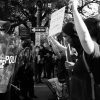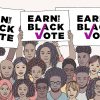
Capital Savings Bank, the first bank organized and operated by African Americans, was founded in Washington, D.C., on Oct. 17, 1888. (Library of Congress)
Capital Savings Bank opened shop in Washington in 1888, making it the nation’s first black-owned bank at a time when the mere notion of offering financial services to the African American community was a novel idea. Now black-run banks are in a fight for survival, even though many advocates argue that many African Americans remain starved for banking services.
The Federal Deposit Insurance Corp. counted 25 black-owned banks remaining in the country last year, down from 48 in 2001. That decrease came even as the overall number of minority-owned banks increased slightly, going from 164 to 174. In addition, the majority of black-owned banks that remain open are on shaky ground and struggling to hold on in the face of the economic devastation that has ravaged many of their customers. Analysts say 60 percent of black-run banks lost money in 2013.
“I would venture to say that [the vast majority of black banks] are in varying degrees of trouble,” said Darrell Jackson, chief executive and president of Chicago’s Seaway Bank, a black-owned bank celebrating its 50th anniversary.
Black-run banks have been struggling for years, as mainstream institutions increasingly picked off their best-heeled customers. The increased competition came amid what some call a string of strategic blunders.The banks, historically headquartered in the heart of traditional black communities such as Chicago’s South Side, New York’s Harlem and Washington, D.C.’s Shaw, failed to modernize their services. Few offered the branch networks, computerized banking and other automated services that have come to dominate the business. And many of the banks failed to follow the African American middle class to the suburbs.
Taken together, black banks control just $5 billion in assets, a tiny fraction of the size of the nation’s banking behemoths, such as Wells Fargo, which by itself has some $1.7 trillion in assets. Black banks tend to be small even by the standard of minority owned banks, which as a group had some $181 billion in assets at the end of 2013, according a FDIC report.
The trouble faced by black banks only deepened during the recession, and they have continued during the recovery. Just a handful of them were eligible for the federal bailout funds that sustained many large financial institutions through the crisis. Now they are challenged by the bleak economic prospects of their core customers. Not only were many black neighborhoods crippled by the mortgage crisis, but the recovery has been been slower in black communities than elsewhere. African Americans continue to lose wealth as their property values have lagged those elsewhere in the years since the financial downturn. Despite an extended period of job growth nationally, the black jobless rate remains above 10 percent.
The economic shock continues to ripple through the black community, upending black business and even churches, which historically have been the best customers for black banks. Meanwhile, many black-owned banks are left with a lot of toxic loans in their portfolios.
“This is such an extremely important sector of the banking community,” said Michael A. Grant, president of the National Bankers Association, the lobbying group for black banks. “We were hit so hard during this sub-prime crisis, and they are having a hard time working their way back from that.”
Others argue that many black-run banks planted the seeds for their own demise by failing to evolve with the times. William Michael Cunningham, an economist and entrepreneur, said many black banks do not do enough to modernize their businesses, and instead rely too heavily on political connections and old business alliances for deposits and customers.
“Being a black banker in a top-30 city in the U.S. is a very good job, mainly because you don’t have to do much,” Cunningham said. “Too often, if you are a black banker, your incentive is not to make loans.”
Paul O’Connor, founder of Angkor Strategic Advisors, a Chicago-based banking consultancy, called black-run banks a victim of the larger progress of African Americans. Like other institutions that thrived in the face of rampant discrimination, black banks now confront more and better financed competition for relatively affluent customers. Meanwhile, few banks see profits in banking the poor. At the same time, he noted, many black communities — particularly impoverished neighborhoods in which black-owned banks tend to be headquartered — remain in dire need of better banking options.
“The positive side of this is that the African American community has developed in a way that they don’t need African American banks like they did 50 or 70 years ago,” he said. “Also, they have a margin for error that is much smaller than most banks. At the end of the day, you are banking human beings and they are as good a credit risk as the last job they had. A lot of people these institutions banked are hurt economically.”
Whatever the root cause of the problems of the problems of black banks, many analysts agree their demise is a net loss, since they disproportionately serve poor communities where banks are few, according to the FDIC.”Often, black banks are the only bank, ore one of two, in the entire zip code,” said Russell Kashian, an economist at the University of Wisconsin, Whitewater. “If they weren’t there, there would be nothing.”
Given that reality, many advocates say their survival should be a priority of both the government and the black community. Black bankers have been lobbying federal officials to relax regulations in a way that would make it less costly to do business. Others say there need to be better incentives and training and mentoring to help sustain the banks. “If we want these underserved neighborhoods served, either we have to make these communities wealthier, or provide some better incentives for these banks to exist,” Kashian said.
The National Bankers Association’s Grant added that more black consumers should make a priority of banking with institutions that served their communities when others would not. “The African American community itself is going to have to do more to support its businesses, which includes the banks,” Grant said. “Why are we boycotting our own businesses? These are the banks that were there for us before integration. We should be there for them now.”














